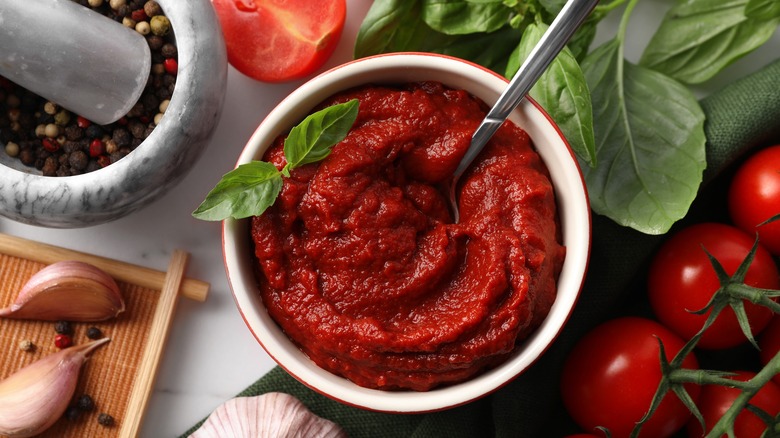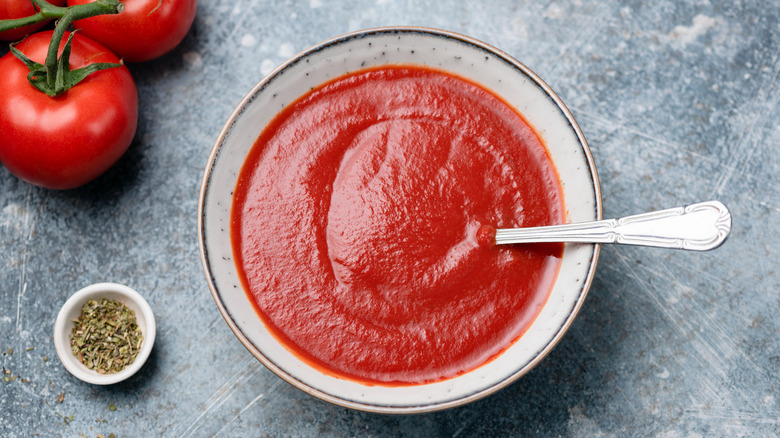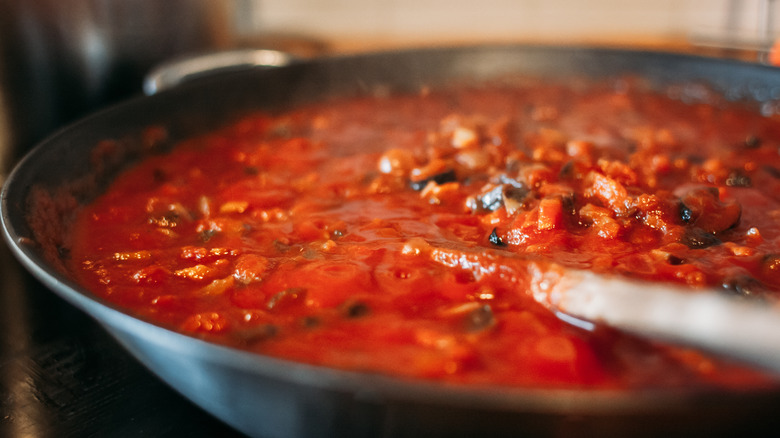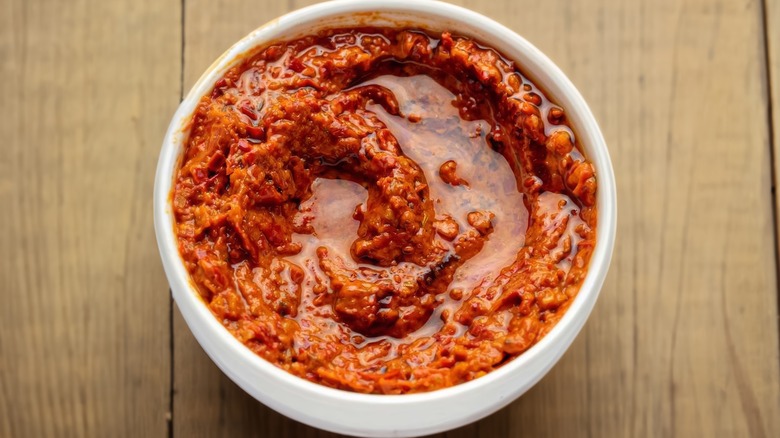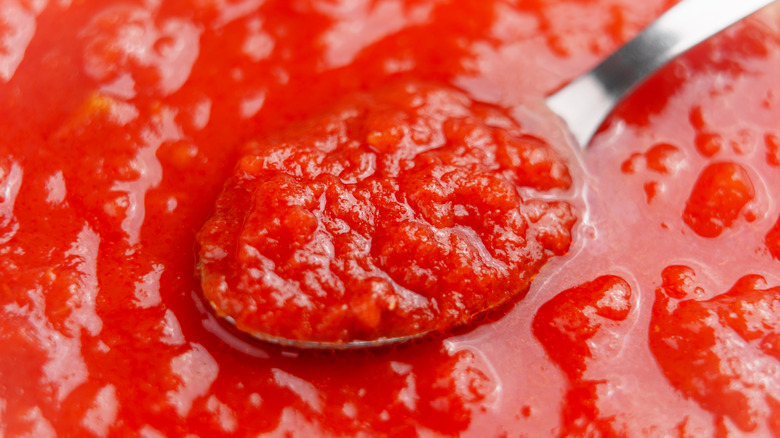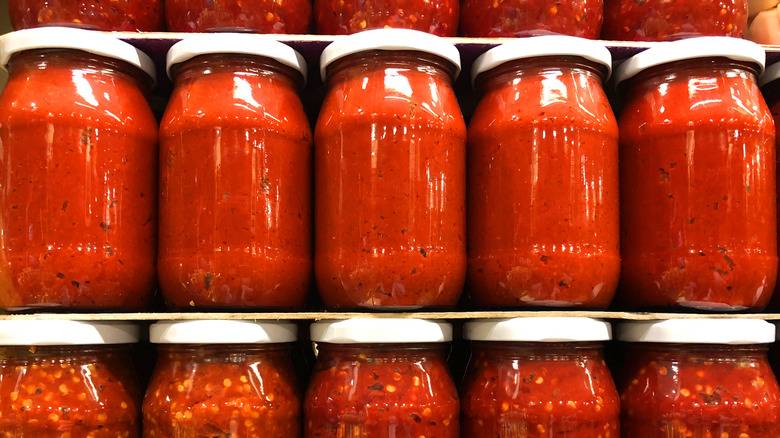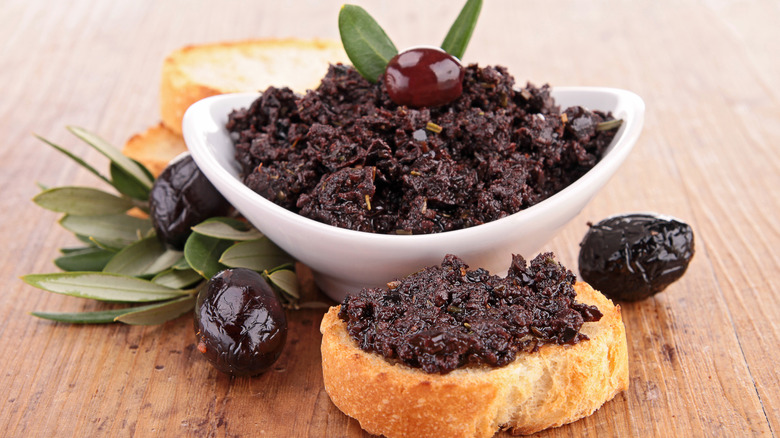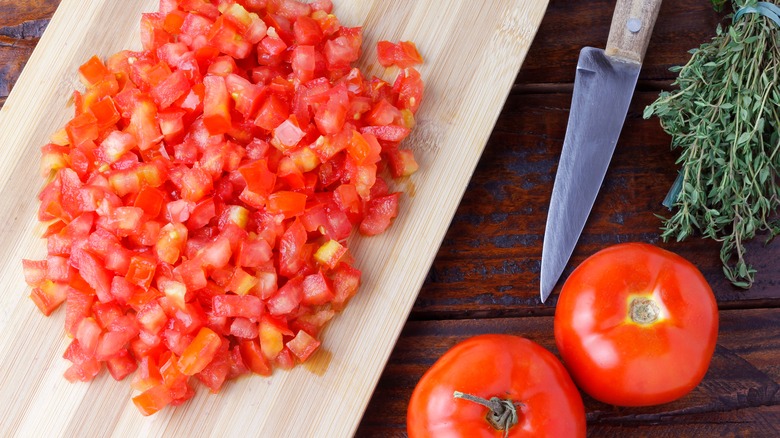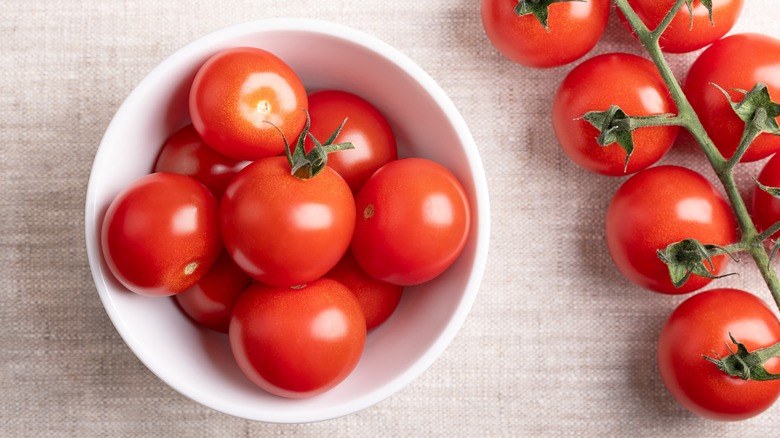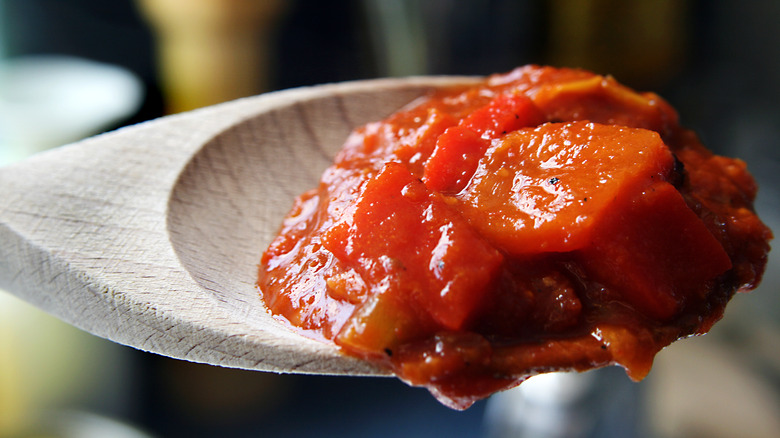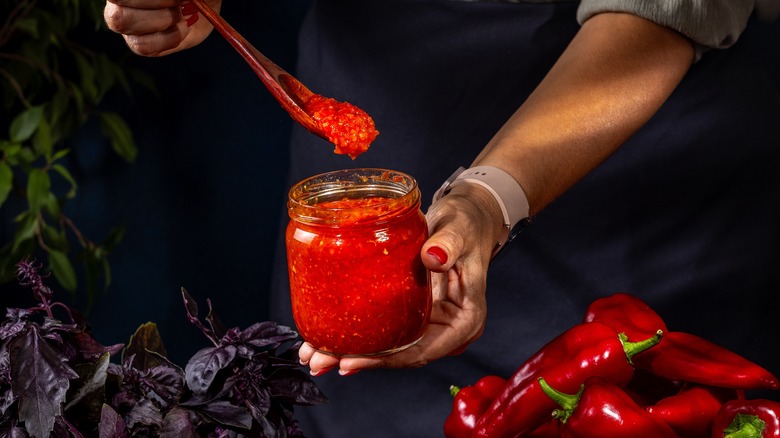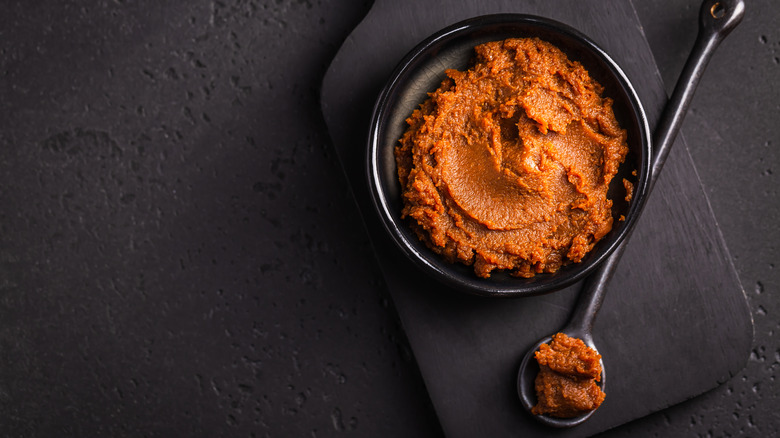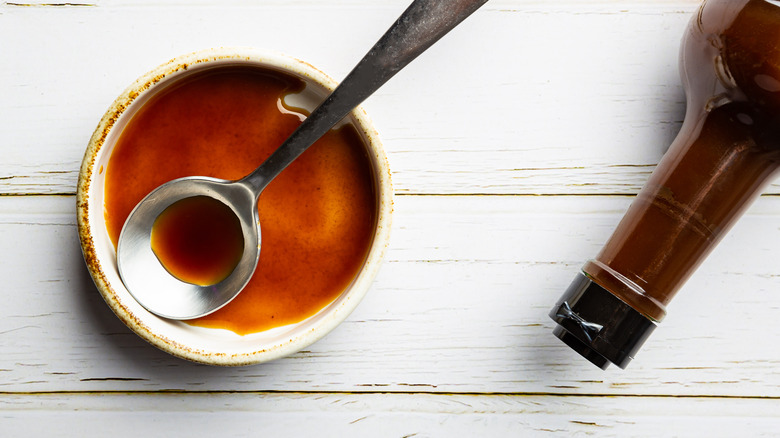What Are The Best Substitutes For Tomato Paste?
We may receive a commission on purchases made from links.
Rich, thick, and intensely flavorful, tomato paste is nearly unmatched in terms of robust savoriness. With its vibrant red hue and notable thickness, it's difficult to imitate such a distinct ingredient. That said, there are times when tomato paste may not be available, and you're left searching for a suitable substitute.
So, which ingredient should you pick? We're glad you asked! There are more options in your pantry than you might think, and we're giving you the 411 on which serve as amazing substitutes. Each tomato paste replacement differs in how it should be used, and will give your entrée a slightly different edge. From swaps that are nearly identical in flavor to alternatives that contain no tomato at all, we're certain you'll find the tomato paste substitute here you never knew you wanted. Join us as we uncover the best options the next time you're in search of a replacement.
Tomato sauce
Tomato sauce works as a tomato paste substitute because it's packed with tomato flavor, though it isn't as concentrated. Tomato sauce is made by cooking tomatoes, and can be infused with garlic and herbs, as with Hunt's Garlic and Herb Pasta Sauce. It's often smooth in texture and melds well in sauces, gravies, and any other base that calls for tomato paste.
Since tomato sauce isn't as concentrated as tomato paste, its flavor won't be as potent, especially when used at a 1:1 ratio. To achieve full-bodied tomato savoriness, we advise using more tomato sauce than you would tomato paste: About 3 tablespoons for every 1 tablespoon should do the trick. Keep in mind that the added liquid may negatively affect the recipe's texture in some cases, so use this substitute with caution. All in all, though it may not capture the exact essence of tomato paste, tomato sauce is a decent substitute to grab when you're in a pinch.
Ketchup
Ketchup is one of the best tomato paste substitutes out there, but you'll need to be cautious when adding it to recipes. Like tomato paste, ketchup is a concentrated tomato product, but it's also infused with flavorings, vinegar, and sugar to deliver a uniquely tangy yet sweet taste. Though enjoyable, this distinct flavor profile sets itself apart from tomato paste.
Because of its sugar content, adding ketchup to any dish in place of tomato paste will undoubtedly yield a sweeter result. We recommend using ketchup as a substitute only in dishes where you won't mind a little extra sweetness. Simply adjust your recipe when necessary: If the recipe already calls for sugar, you may want to cut back on it to compensate for the sweetness of the ketchup.
Ketchup is also not quite as thick or concentrated as tomato paste in terms of texture and flavor. Ketchup brands differ greatly when it comes to flavor, so keep that in mind when replacing your tomato paste with ketchup in any recipe.
Tomato soup
Tomato soup might sound like a bit of an odd ingredient to use as a tomato paste substitute, but if you're in a pinch, it'll work. Though it features a liquid-like consistency and does not have the same potent tomato flavor, tomato soup can be used as a substitute with some caveats.
First, you'll need to decrease the amount of liquid you use in your recipe to compensate for the soup's texture and consistency. How much liquid you'll need to cut out will depend on how much tomato soup you use. If you use a full 10.75-ounce can, you may need to cut back on the other liquids in your recipe by as much as ½ cup. You'll also need to account for the taste. Some tomato soup brands have unique seasonings that may or may not suit your recipe.
Another thing to consider when using tomato soup as a substitute is the sodium content. While tomato paste tends to be relatively low in sodium, some tomato soup brands can have a much higher amount. Consider using a lower-sodium tomato soup option like Campbell's Condensed Unsalted Tomato Soup, or simply cut back on the salt in your recipe to avoid an overly briny dish.
Tomato purée
Tomato purée is another great tomato paste substitute, and cooking it before use can make it even better. Since tomato paste is simply cooked-down tomato with juices and seeds removed, cooking tomato purée until it has reduced can yield a similar ingredient. If you aren't in the mood to break out the pots and pans, you can use tomato purée as is, though it won't be as thick. Also keep in mind that uncooked tomato purée also won't have as concentrated a flavor as tomato paste.
Similar to using tomato sauce, you'll want to replace every 1 tablespoon of tomato paste with 3 tablespoons of tomato purée for a similar flavor. Depending on how much tomato paste the recipe calls for, you may need to reduce the amount of liquid in your dish due to the purée's thinner consistency.
Harissa
Hailing from North Africa and the Middle East, harissa can offer a distinct and flavorful touch to certain dishes. Harissa is a condiment made from chilis that contains garlic and spices. It packs a spicy and smoky flavor that can lend an unexpected backdrop of subtle heat to dishes like soups, stews, and beans. It is about as spicy as a jalapeño, meaning it's not scorching hot but not unnoticeable either.
Be careful when adding harissa as a tomato paste substitute: Using too much may overpower your dish, especially if you aren't familiar with how to use harissa in the kitchen. All in all, while harissa might not impart the tomato-y flavor you're used to, the punch of flavor is a worthy substitute for tomato paste, and can bring something different to your tomato-based recipes.
Crushed tomatoes
Crushed tomatoes are essentially tomatoes that are — you guessed it — crushed, to create a thick tomato base chock full of hearty texture and flavor. Crushed tomatoes, such as Contadina Crushed Tomatoes, typically have few seasonings, making them a tomato-forward yet neutral choice for dishes. Recipes like chili, stew, soup, pizza sauce, and pasta sauce are only a few that would benefit from this easy tomato paste swap.
When using crushed tomatoes as a tomato paste substitute, try using it at a 3:1 ratio like you would with tomato purée or sauce. Though crushed tomatoes include many tomatoes, the flavor isn't too concentrated, since the tomatoes haven't been reduced or drained. Using a little more tomato than called for is fine, but, as always, be sure to account for the added liquid by adjusting the amount of other liquid ingredients, such as water, milk, or broth, to prevent cooking up a soupy dish.
Marinara sauce
Marinara sauce is a great tomato paste substitute given its flavor and consistency, but you'll need to watch out for added ingredients. Marinara sauce is different from tomato sauce in that it is typically thinner, chunkier, and brighter-tasting. It is also more tomato-y and requires less cooking time than tomato sauce.
Cooking this ingredient for a while to make it thicker is always an option if you want a consistency similar to tomato paste. It could also help concentrate the tomato flavor by allowing some of the juices to evaporate. If you don't feel like cooking it down, you can add your marinara as is — just be sure to account for the extra liquid in your recipe.
Remember that store-bought marinara sauces often feature herbs and aromatics, so make sure the flavor of your marinara complements your recipe. If, for example, you wish to replace the tomato paste in a lean taco filling with marinara, doing so might prove tricky as the Italian flavors may clash with the traditional Mexican ingredients in taco meat. So although marinara sauce is a decent substitute, using it may work best for Italian recipes.
Tomato passata
Tomato passata is another possible substitute for tomato paste. Though many people think tomato passata is the same as tomato purée, there are key differences. Tomato passata is a type of purée, but it is always strained to remove seeds and never comes cooked. Tomato passata usually contains very few seasonings, yielding impeccably potent, rich, and unadulterated tomato flavor. Cooking passata to intensify its flavors takes less time than reducing whole fresh tomatoes — a major bonus when using it as a substitute for tomato paste.
When using tomato passata as a tomato paste substitute, we'd recommend our usual rule of 3 tablespoons of passata for every 1 tablespoon of tomato paste. Adjust the liquid in your recipe as needed. Also, be sure to taste as you go to ensure the flavor you wish to impart is present. Just keep in mind that while tomato passata is a good substitute, it isn't usually as robust in flavor as tomato paste, even when used as we've directed.
Olive tapenade
Olive tapenade isn't anything close to actual tomato paste, but if you want to infuse your dish with salty umami taste, this is a substitute you might want to check out. Rich in color and flavor, olive tapenade is typically made of olives, capers, anchovies, and seasonings, though the exact ingredients may vary from brand to brand. And though olive tapenade doesn't carry the same tomato flavor as tomato paste, it makes a great substitute for heavy sauces, creating a pasta dish that's lighter and just as flavorful.
Not only can tapenade offer depth to dishes like pasta and other entrées where tomato paste is used, but it can also prove a useful swap for people who find tomato-based sauces too acidic. While you can certainly balance out acidic tomato sauce with veggies, using olive tapenade eliminates the hassle, making it a great pick overall.
Note that the color of your olive tapenade will depend on the type of olive you choose, but will usually take on a brownish-black hue. If presentation matters to you, ensure the color of this substitute suits the entrée you're swapping it in for before making the switch.
Diced tomatoes
Diced tomatoes as a tomato paste substitute? Sometimes. While options like tomato sauce, tomato purée, crushed tomatoes, and marinara sauce will deliver bolder, richer, and more flavorful results, diced tomatoes can work too as long as you know how to use them. For the best results, simmer your diced tomatoes to develop their flavor and help evaporate their juices.
There are many types of diced tomatoes to choose from, including fresh tomatoes diced by hand and canned varieties. If you plan to use canned diced tomatoes, always pay attention to the variety. Diced tomatoes labeled "fire-roasted," for example, will yield a distinct flavor that may or may not jive with your recipe. If diced canned tomatoes prove too acidic for you, try adding baking soda as an easy fix. It's likely already in your pantry and won't change the taste of your dish, provided you don't add too much.
Of course, you can still use uncooked diced tomatoes as a substitute, but the flavor won't be as strong. You'll also want to account for the difference in texture — diced tomatoes tend to be rather large and chunky, with a lot of juice. Be prepared for pieces of tomato throughout the dish with a much less pronounced tomato flavor when using uncooked diced tomatoes in place of tomato paste.
Fresh whole tomatoes
Did you know that you can use fresh tomatoes to make tomato paste? It's true. You can remove the tomato skins first or simply cook the tomatoes as they are until reduced. You can then push the tomatoes through a sieve to eliminate seeds and bake in the oven until the tomatoes form a paste.
Of course, you could chop up fresh whole tomatoes for your recipe, but beware — this will not have the same consistency or flavor as traditional tomato paste. If you really want to use fresh whole tomatoes in your next recipe in place of tomato paste, we'd strongly recommend cooking them first. Otherwise, expect light, bright, and tomato-forward flavors that aren't quite as rich or as thick as tomato paste.
When making tomato paste, try using San Marzano tomatoes or even Roma tomatoes, as this will get you more paste than other varieties. Bake the tomatoes until they are glistening with a rusty red hue. Freeze any leftover tomato paste in an ice cube tray for easy retrieval for future use.
Salsa
Though red salsa might not meld well with Italian dishes, it can be a great tomato paste substitute for South American fare. Red salsa usually lends a deeply rich tomato flavor and is often essenced with South American herbs and spices. Cilantro, onion, and bell peppers are ingredients commonly found in this spicy red sauce. This alternative might work well as a substitute in dishes like chili, taco meat, or southwestern soups.
If you use salsa as a tomato paste replacement in your dish, add it at a 1:1 ratio and taste as you go. If you think your dish needs more tomato flavor, add a little more until it tastes as desired. We recommend using salsa sparingly, as its tomato flavor and spices can be pretty strong. Be sure to check the heat level of the salsa you choose — if you don't like spicy food, steer clear of salsas labeled "hot." Mild and medium varieties are also available, like this Mild Pace Chunky salsa, so pick the one that suits your taste buds best.
Last but not least, remember that there are other types of salsa that may also work well as substitutes. Homemade salsa verde, for example, is another great option, provided that you're okay with the green color. As with red salsa, you'll use it at a 1:1 ratio, making adjustments as needed in accordance with the desired taste.
Ajvar
With a texture similar to tomato paste, you may wish to consider ajvar as your next tomato paste substitute. Like harissa, ajvar isn't tomato-based, but contains ingredients that make it a similar yet distinct alternative for tomato paste in recipes. Its base is comprised of roasted red peppers and often contains oil, vinegar, and salt. It isn't as readily available in North American or European grocery stores as tomato paste, but you can find some brands online, such as this Marco Polo All Natural Ajvar on Amazon.
Unlike harissa, ajvar isn't usually spicy, so there's no need to worry about infusing extra heat to your dish. When using it as a substitute, start by adding it gradually, depending on the amount of roasted red pepper flavor you desire. Since ajvar isn't tomato-based, you can expect it to alter the flavor of the original recipe quite a bit, but as long as it is a dish that could benefit from the sweet flavors of red peppers, it's worth a shot!
Miso paste
Miso paste is made from fermented soybeans and, like a few of the other options on the list, can be a surprisingly good substitute for tomato paste. Miso paste is known for making food taste better given its deep umami flavor. It works well as a tomato paste substitute for dishes containing meat and layers of hearty flavor. Miso paste is rather thick, so it will need to be diluted, either in water, broth, or another liquid, to help achieve a tomato paste-like consistency.
With the deeply savory flavors of miso paste, you won't necessarily want to place it in dishes where bright and tomato-y tastes are front and center. Still, miso paste can provide a rich backdrop to the right meals, such as soups and stews. When using miso paste as a substitute for tomato paste, add it to taste, especially if you aren't used to cooking with this ingredient.
A tomato base and Worcestershire sauce
One of the best recommendations we have for creating a like-to-like replacement for tomato paste is to use one of the tomato-based replacements mentioned earlier along with Worcestershire sauce. Worcestershire sauce is made with various ingredients including vinegar, sugar, molasses, and anchovies, though the exact ingredients often vary by brand. It has a very rich and distinct umami taste with a hint of sweetness that, when paired with other tomato-based replacements, mimic the flavor of tomato paste and then some.
We love using this combination to upgrade plain spaghetti sauce, where a balance of savory and sweet combine to provide rich flavor. Adding equal parts ketchup and Worcestershire sauce is the way to go for the best tomato paste imitation, though you should note that this swap can prove a little sweeter than others. Adding Worcestershire sauce to tomato sauce, diced tomatoes, or other replacements works well too. When adding Worcestershire sauce to a recipe, take it easy, and taste as you go. A little goes a long way, so be cautious to avoid ruining the flavor of your dish.
